Here is the comprehensive guide on drill bit tip types! Selecting the right drill bit point is crucial for achieving clean, accurate holes and maximizing drilling efficiency across various materials. Whether you’re working with wood, metal, or masonry, understanding the nuances of different tip geometries will significantly impact your results.
In this blog, we’ll delve into the world of drill bit point designs, exploring their unique characteristics and ideal applications. From the common twist bit point to specialized options like brad point and spade bits, we’ll break down which point works best for different materials, ensuring you choose the perfect bit for your next project.
What is a Drill Bit Tip

The drill bit tip is the pointed or shaped end of a drill bit that initiates contact with the workpiece and begins the cutting action to create a hole. Its design, including the point angle, number of cutting edges (lips), and any specialized features like spurs or pilot points, is crucial for determining the bit’s efficiency, accuracy, and suitability for different materials.
The geometry of the tip influences how the bit penetrates the material, how chips are evacuated, and the overall quality of the drilled hole. Different drill bit tip types are engineered for specific applications, ensuring optimal performance whether drilling wood, metal, plastic, masonry, or other materials.
What is the Tip of a Drill Bit Called?
The pointed end of a drill bit, which initiates the cutting action, is generally referred to as the point or the tip. However, depending on the specific design and function of that end, it can have more descriptive names.
For standard twist drill bits, the pointed end is simply called the drill point. For drill bits designed for wood, like brad point bits, the sharp central protrusion is specifically known as the brad point. Similarly, self-feeding wood bits feature a screw point.
Masonry bits have a carbide tip, often with a chisel-like edge. Therefore, while “tip” and “point” are general terms, the specific design of the cutting end often warrants a more precise name.
Drill Bit Tip Types
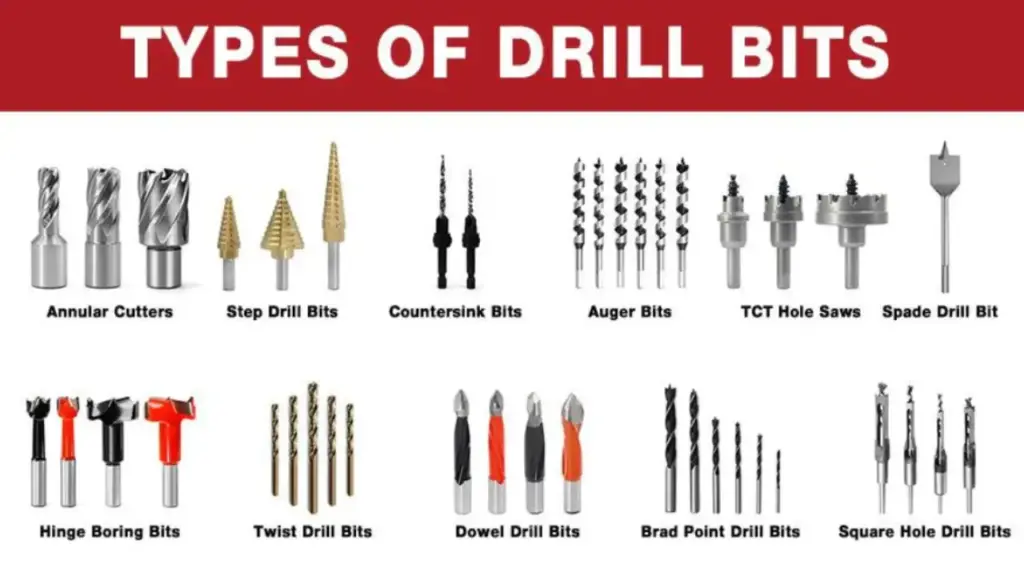
Exploring the diverse world of drill bit tips reveals specialized designs tailored for specific materials and applications. The tip’s geometry is crucial for initiating the cut, efficiently removing material, and achieving the desired hole quality.
Understanding these variations allows for optimal tool selection and improved drilling outcomes across a wide spectrum of tasks, from delicate woodworking to robust metal fabrication.
Twist Drill Bits
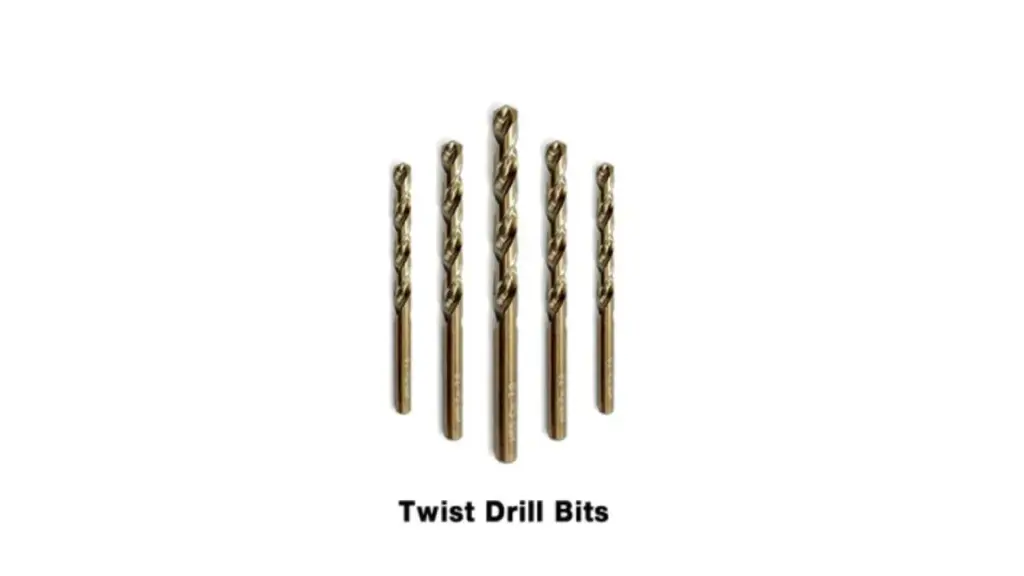
Twist drill bits are perhaps the most common type, featuring a conical point with two cutting edges (lips) and helical flutes that remove chips. The standard point angle is 118 degrees, suitable for general-purpose drilling in wood, plastic, and soft metals. Variations include split-point tips, which have a notched web to prevent walking and eliminate the need for a pilot hole, and different point angles optimized for specific materials like harder metals (more obtuse angles).
The versatility of twist drill bits makes them a staple in most toolkits. Their helical design efficiently evacuates chips, reducing heat buildup and preventing clogging. While effective for a wide range of materials, they can sometimes wander on smooth surfaces without a pilot hole, and their cutting action relies on the two lips, which can require significant thrust force, especially in harder materials.
Brad Point Drill Bits
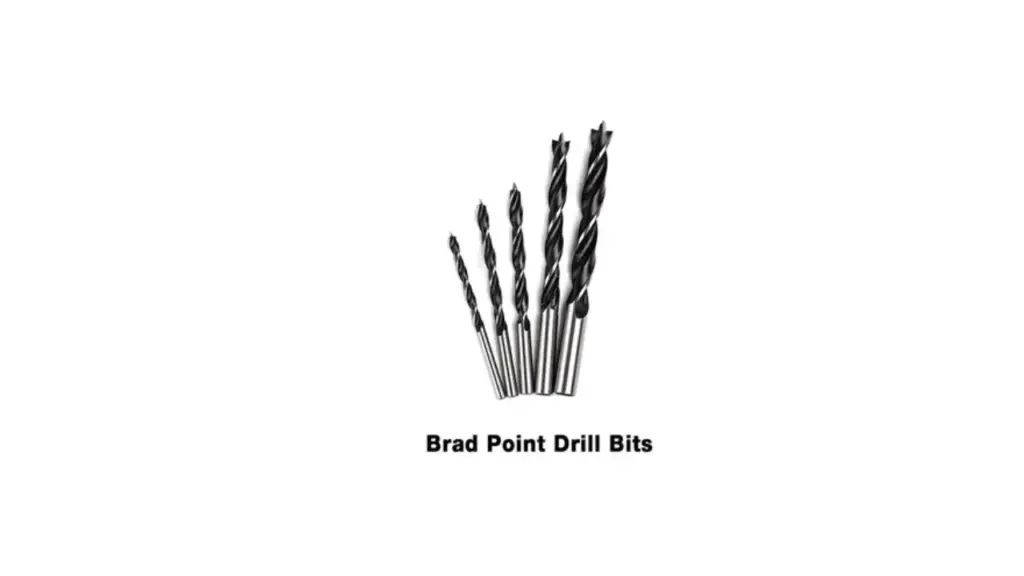
Best for: Boring precise, clean holes in wood.
Brad-point drill bits are designed to provide precision and clean cuts in wood. This bit has a sharp point at the tip with spurs on the cutting edges. The central brad helps position and stabilize the bit accurately, while the extra-wide flutes efficiently remove wood chips and dust.
These bits are ideal for tasks such as drilling cabinet doors for hardware installation. Some models include rubber stoppers to preset the desired hole depth, enhancing precision and consistency. Their design minimizes tear-out, resulting in a clean entry and exit of the hole.
Spade Drill Bit
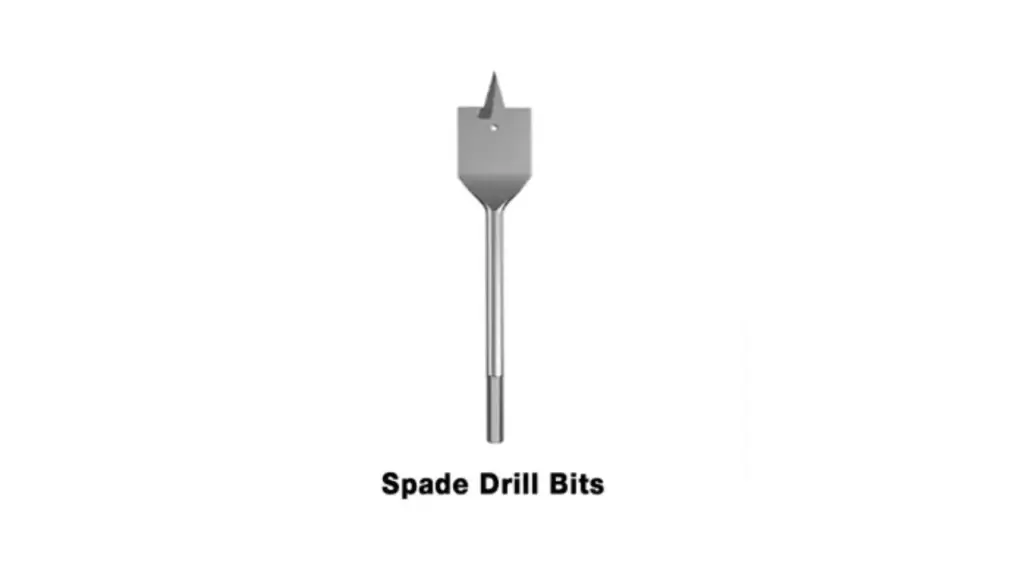
Best for: Drilling large-diameter holes in wood quickly.
Spade drill bits, also known as flat bits, feature a flat blade with a pointed tip for centering. The cutting action occurs along the two flat edges of the blade. They are designed for rapid material removal in wood, creating large-diameter holes for plumbing or electrical installations.
While efficient for drilling large holes quickly, spade bits tend to produce rougher holes with more splintering compared to other wood-drilling bits. They can also be prone to wandering, especially when starting the hole, and require a firm grip and moderate speed for best results.
Step Drill Bits
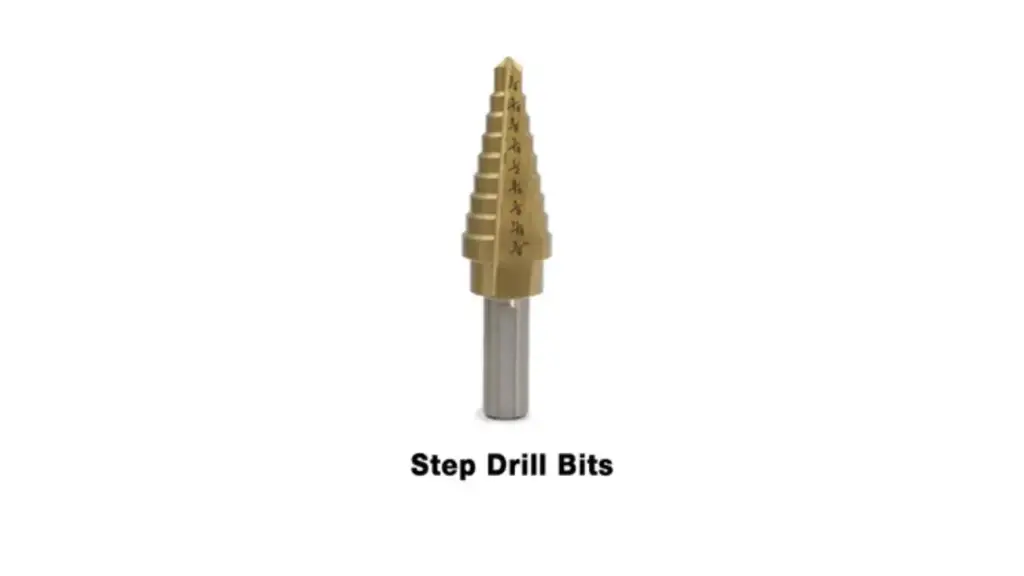
Best for: Drilling multiple-sized holes in thin materials like sheet metal.
Step drill bits have a stepped conical shape with increasing diameters. The tip starts a small hole, and as you push further, it drills larger sizes according to the steps. They are excellent for creating clean, burr-free holes of varying diameters in thin materials like sheet metal, plastics, and some composites.
The stepped design eliminates the need for multiple drill bits, saving time and effort. They also help to deburr the edges of the hole as they drill. However, they are not suitable for drilling thick materials or creating flat-bottomed holes.
Countersink Bits
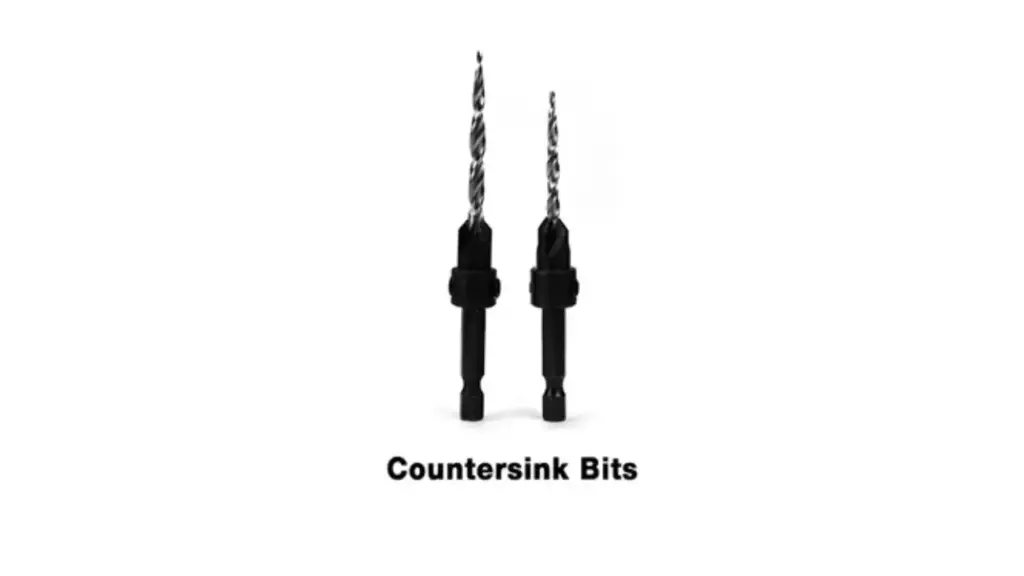
Best for: Creating a conical recess around a screw hole to allow the screw head to sit flush with the material surface.
Countersink bits have a conical shape with cutting edges designed to create a chamfer or countersink. They are used after drilling a pilot hole to prepare the surface for a flat-head screw, allowing it to sit flush or below the surface of the material.
These bits ensure a clean and professional finish for screw installations. They come in various angles to match different screw head types. Some countersink bits are integrated with a drill bit for a one-step drilling and countersinking process.
Auger Bits

Best for: Drilling deep, large-diameter holes in wood.
Auger bits feature a screw-point tip that pulls the bit into the wood, followed by wide spiral flutes (augers) that efficiently remove large amounts of wood chips. They are designed for drilling deep holes for tasks like timber framing or running cables.
The self-feeding action reduces the effort required to drill deep holes. However, they typically operate at lower speeds and require a drill with sufficient torque. They are specifically for wood and not suitable for metal or masonry.
TCT Hole Saws
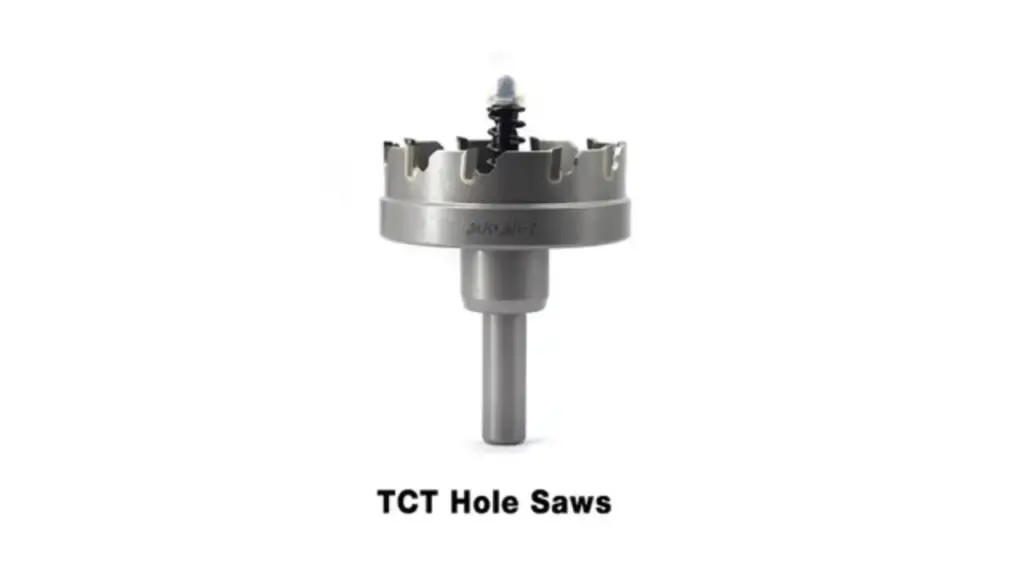
Best for: Cutting large-diameter holes in various materials, including wood, metal, and plastic.
TCT (Tungsten Carbide Tipped) hole saws consist of a cylindrical saw blade with teeth made of tungsten carbide, attached to an arbor with a pilot drill bit in the center. The carbide teeth provide excellent hardness and wear resistance, allowing them to cut through tougher materials than standard bi-metal hole saws.
These hole saws create clean, accurate large-diameter holes for installing hardware, running pipes, or creating access points. The pilot drill bit guides the saw and ensures the hole is centered correctly.
Annular Cutters
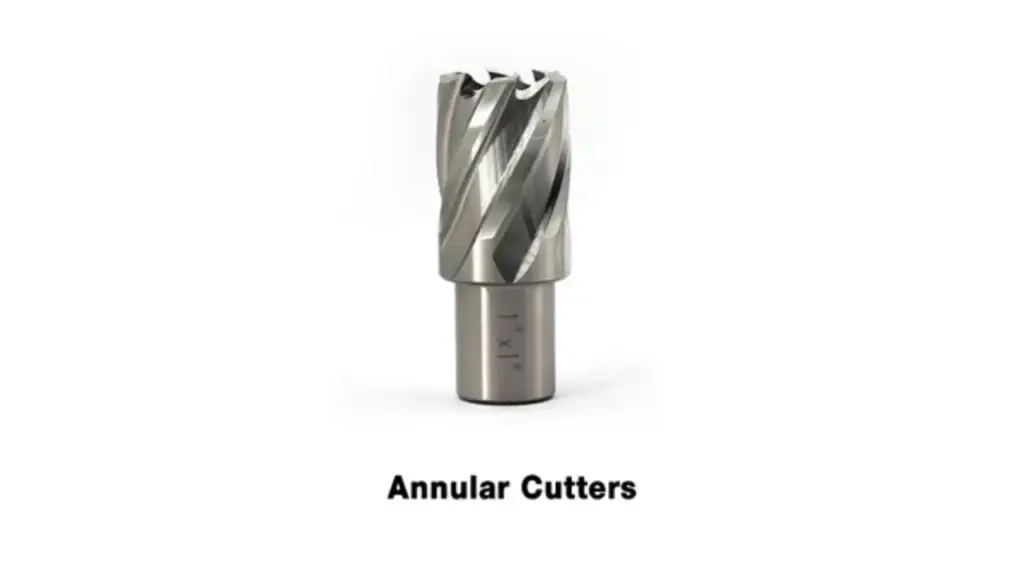
Best for: Drilling precise, overlapping holes in metal with a smooth finish.
Annular cutters, also known as core drills, are hollow cylindrical cutters with teeth around the circumference and a pilot pin in the center. They cut a hole by removing a core of material, rather than the entire diameter, making them more efficient for larger holes in metal.
They produce clean, accurate holes with a smooth finish and are commonly used in metal fabrication and machining. They require specialized magnetic drill presses or rotary broaching machines.
Hinge Boring Bits

Best for: Drilling precise, flat-bottomed holes for concealed hinges in cabinet doors.
Hinge boring bits, often Forstner-style or specialized designs, are used to create the precise, flat-bottomed holes required for installing concealed hinges on cabinet doors. They feature a central pilot point and circular cutting edges that score the wood fibers before removing the material.
These bits ensure accurate depth and a clean, flat bottom for the hinge cup to sit flush. They often come in standard sizes that match common hinge dimensions.
Dowel Drill Bits

Best for: Drilling precise, clean, and flat-bottomed holes for dowel joints in woodworking.
Dowel drill bits are designed to create accurate, clean, and often flat-bottomed holes for dowel pins used in woodworking joinery. They typically feature a brad point for precise centering and sharp cutting edges to ensure clean sides and a flat bottom for optimal dowel fit.
The precision of these bits is crucial for strong and accurate dowel joints. Some may have depth stops to ensure consistent hole depth for alignment.
Square Hole Drill Bits
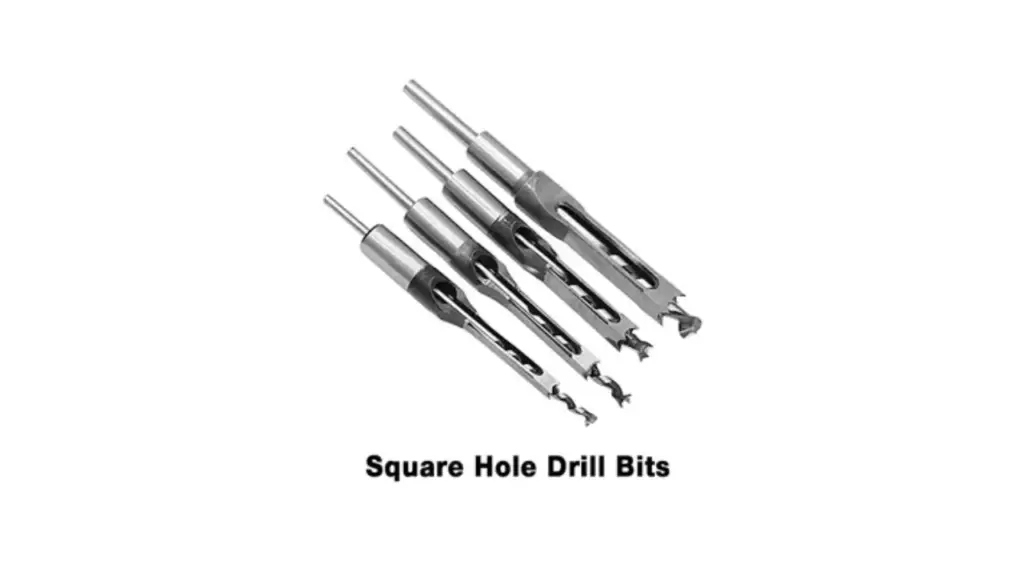
Best for: Creating square holes in wood with a specialized drilling machine.
Square hole drill bits, used in conjunction with a mortising attachment on a drill press, consist of a drill bit inside a square chisel. The drill bit removes most of the material, and the chisel squares the corners of the hole.
This system is used to create precise square or rectangular mortises for woodworking joinery, such as for mortise and tenon joints. It requires a specialized setup and is primarily used in woodworking applications.
| Drill Bit Type | Primary Use | Key Tip Features | Material Suitability |
| Twist | General purpose drilling | Conical point, cutting lips, helical flutes | Wood, Plastic, Soft Metals |
| Brad Point | Precise, clean holes in wood | Sharp central spur, outer cutting spurs | Wood |
| Spade | Large-diameter holes in wood (fast) | Pointed tip, flat blade edges | Wood |
| Step | Multiple-sized holes in thin materials | Stepped conical shape | Sheet Metal, Thin Plastics |
| Countersink | Creating recesses for flush screw heads | Conical shape with cutting edges | Wood, Metal, Plastic |
| Auger | Deep, large-diameter holes in wood | Screw-point tip, wide spiral flutes | Wood |
| TCT Hole Saw | Large-diameter holes in various materials | Cylindrical blade with tungsten carbide tipped teeth, pilot bit | Wood, Metal, Plastic |
| Annular Cutter | Precise, overlapping holes in metal (smooth) | Hollow cylinder with teeth, pilot pin | Metal |
| Hinge Boring | Flat-bottom holes for concealed hinges | Central pilot, circular cutting edges | Wood |
| Dowel | Precise, flat-bottom holes for dowel joints | Brad point, sharp cutting edges | Wood |
| Square Hole | Creating square holes in wood | Drill bit inside a square chisel | Wood (with mortising attachment) |
How to Choose the Best Drill Bit Tips
Selecting the most suitable drill bit tip hinges on a clear understanding of the material you intend to drill and the specific requirements of your project. Different tip geometries are engineered to optimize performance in various materials, ensuring clean cuts, efficient material removal, and accurate hole placement.
By considering the material’s hardness, brittleness, and grain (if applicable), as well as the desired hole quality and depth, you can narrow down your options and choose a tip that will deliver the best results for your task.
Here are key factors to consider when choosing a drill bit tip:
- Material Type: Match the tip material and geometry to the workpiece (e.g., wood, metal, masonry, plastic, tile).
- Hole Size: Some tip types are better suited for specific diameter ranges (e.g., spade bits for large holes in wood).
- Hole Depth: Auger bits are designed for deep holes in wood, while standard twist bits handle shallower depths well.
- Precision Requirements: Brad point and center drill bits excel in accuracy, while spade bits prioritize speed over finish.
- Drilling Speed and Feed Rate: Certain tips perform better at specific speeds; consider the material’s properties and the bit’s design.
- Coolant Needs: Drilling harder materials often requires coolant, and some bit designs facilitate better coolant flow.
- Pilot Hole Necessity: Some tips (like split point twist bits and brad points) eliminate the need for a pilot hole.
- Desired Finish Quality: Brad point and Forstner bits produce cleaner holes in wood than spade bits.
- Durability Requirements: For repetitive drilling in tough materials, carbide-tipped or cobalt bits with appropriate tip geometry are crucial.
- Cost Considerations: Balance the performance benefits of specialized tips with your budget for occasional versus professional use.
Conclusion
Selecting the correct drill bit tip is paramount for achieving clean, accurate holes in various materials. Understanding the nuances of point angles, shapes, and specialized designs empowers users to optimize drilling performance and prevent material damage. Whether working with the sharp spur of a brad point for wood, the robust split point for metal, or the aggressive screw point for self-feeding action, the tip dictates efficiency and finish quality.
Choosing the right drill bit tip not only improves the outcome of your projects but also extends the life of your drill bits and power drilling tools. Matching the tip geometry to the material’s properties ensures effective cutting and reduces unnecessary stress on the equipment. Investing time in understanding these differences ultimately leads to more professional and satisfying results across a wide range of drilling applications.
For businesses seeking a reliable source of diverse drill bit types, Sinodrills offers a comprehensive selection for wholesale purchase. Equipping your inventory with a variety of quality drill bits, each featuring optimized tip designs, will cater to a broader customer base and ensure they have the right tool for every job. Consider Sinodrills for your wholesale drill bit needs to provide your customers with performance and precision.


